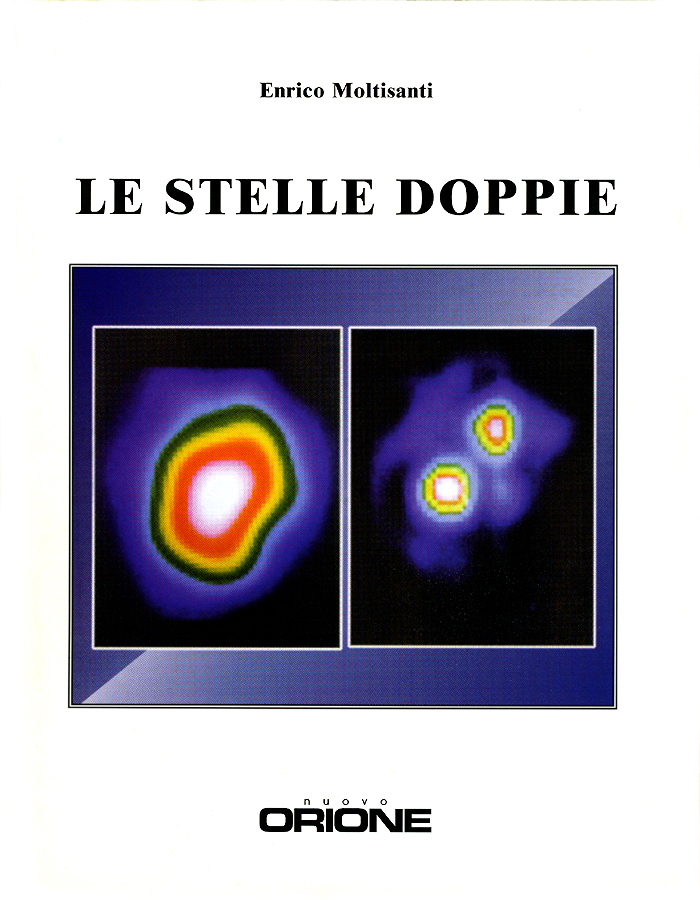|

"LE STELLE DOPPIE"
Il mio volume di 176 pagine "LE STELLE DOPPIE" tratta uno specifico tipo di astri, ovvero le stelle binarie. Il libro è stato pubblicato e stampato per la prima volta nel 1998, quindi ristampato nel 2010. L'ISBN di questo libro (International Standard Book Number) è: 978-88-95650-02-9. Lo studio delle stelle doppie ha rappresentato un caposaldo insostituibile per lo sviluppo dell'astronomia e la comprensione della realtà che ci circonda: le stelle doppie, infatti, hanno permesso di stabilire alcuni fra i parametri fondamentali della fisica delle stelle, tra cui la determinazione della loro massa.
Il libro inizia dai concetti basilari e più elementari, e giunge fino agli sviluppi più recenti; pur partendo dal piano terreno, o quasi, l'ascensore salirà poi piuttosto in alto, cosicché anche gli astrofili esperti troveranno non solo notizie sugli sviluppi più recenti delle nuove tecniche osservative delle stelle doppie, ma anche una grande quantità di dati. Il volume contiene inoltre notizie utili e suggerimenti pratici per osservare e fotografare al meglio le stelle doppie attraverso un telescopio amatoriale. Una tabella riepiloga alcune fra le più belle stelle doppie visibili dai cieli italiani, mentre un vasto elenco riporta i dati aggiornati di 360 coppie tra le più facili da osservare: la possibilità di ammirare nel campo di vista di un telescopio questi astri luminosi e spesso stupendamente colorati - come scintillanti pietre preziose appuntate sopra il velluto nero dello spazio - dovrebbe verosimilmente infondere ossigeno e adrenalina, e dare una sferzata di entusiasmo a molti appassionati del cielo, sia vecchi che nuovi. I più pignoli potranno verificare la bontà ottica dei loro telescopi utilizzando un'apposita tabella di stelle doppie da test, che riporta la separazione angolare precisa al centesimo di secondo d'arco di 36 binarie, calcolata ad intervalli di cinque anni fino al 2030. Tutti i dati riportati nel libro sono stati aggiornati in base alle risultanze dei due monumentali cataloghi prodotti a partire dai dati del satellite astrometrico Hipparcos dell'ESA, l'Agenzia Spaziale Europea (European Space Agency).
L'immagine classica ed iconografica che viene subito in mente, quando si parla di stelle doppie, è quella di qualche vecchio e grande telescopio rifrattore, dal tubo enormemente lungo in proporzione al diametro. Un'immagine, insomma, di un tipo di astronomia ancora un po' eroica, da fine dell'Ottocento: dei tempi in cui Edward Emerson Barnard e Robert Grant Aitken gareggiavano in prima fila, alle prese con i colossali e favolosi rifrattori di Yerkes e di Lick, veri gioielli di ingegneria ottica e meccanica.
Ma da allora, in realtà, molto è cambiato, e persino il seeing, cioè il disturbo provocato dalla nostra atmosfera che impedisce di superare determinate prestazioni ottiche, viene oggi spesso aggirato, vinto e superato. L'occhio dell'astronomo, ormai, è stato vantaggiosamente sostituito da una serie di complicati dispositivi elettronici, dal funzionamento quanto mai interessante ed ingegnoso. Alla fine di questo volume, si avrà la sensazione di aver sollevato un velo su un settore di ricerca in piena attività ed in rapidissimo, folgorante sviluppo, che sta raggiungendo dei risultati del tutto impensabili fino a poche decine di anni fa; ben lontano, insomma, da quell'immagine oleografica ed un po' romantica dei vecchi e silenziosi rifrattori a cui, forse, eravamo rimasti nostalgicamente attaccati.
Oggigiorno, i temi astronomici maggiormente di moda sono relativi alle galassie, alla cosmologia e all'astrofisica delle alte energie: questa tendenza, che appare in tutta evidenza dal contenuto delle riviste professionali specializzate a carattere internazionale, si vede nettamente riflessa anche negli articoli pubblicati sulle riviste di livello meramente divulgativo ed informativo. E tuttavia, sarebbe un grosso errore di miopia - anzi: di presbiopia - dimenticare che le stelle doppie sono un campo estremamente interessante ed avvincente, attualmente in fase di evoluzione tumultuosa.
Oltre a costituire un utile aggiornamento per chi nutre una genuina curiosità ed uno spiccato interesse culturale verso la vasta e meravigliosa scienza del cielo, il contenuto di questo libro è stato sviluppato in modo particolare anche pensando a chi, armato di spirito d'intraprendenza e di voglia di fare, desidera osservare le stelle doppie attraverso un telescopio. Vasta è l'offerta di telescopi di tipo amatoriale e, lungo le pagine del libro, vedremo tra l'altro come orientarsi in merito alla scelta ed al migliore utilizzo di uno strumento particolarmente adatto a questo tipo di astri, chiarendo in modo esauriente che cosa possiamo aspettarci di osservare ponendo l'occhio all'oculare, oppure la macchina fotografica nel piano focale.
Un elemento che gioca un ruolo molto importante a favore delle stelle doppie, è il fatto che questi astri possono venire perfettamente e proficuamente osservati al telescopio anche in presenza della Luna e persino sotto il cielo di una grande città, cioè disturbato in misura sensibile da luci artificiali oltre che non particolarmente libero da foschia e da smog; ben differentemente, perciò, dall'osservazione degli agognati e difficili oggetti deboli del cielo profondo - ammassi stellari e soprattutto nebulose e galassie - che, al contrario, richiedono la presenza di un cielo di alta montagna davvero limpido come il cristallo e nero come il carbone, sempre più difficile e scomodo da trovare.
Se qualcuno, giunto al termine di questo libro, sentirà il desiderio di osservare le stelle doppie in un telescopio, meravigliandosi dinanzi ai loro bellissimi colori, se qualcuno inizierà ad osservarle seriamente e sistematicamente, se qualcuno riuscirà a procurarsi un micrometro per procedere alla loro misura, se qualcuno sarà così curioso da costruirsi un interferometro personale e se - soprattutto - qualcuno al termine della lettura si accorgerà che gli sono spuntate altre domande in testa e vorrà saperne ancora di più, ebbene, allora lo scopo per cui è stato scritto questo libro sarà stato raggiunto, con una grande e particolare soddisfazione.
|

